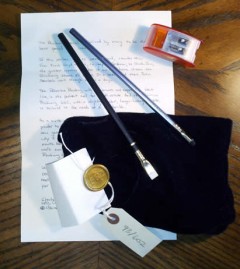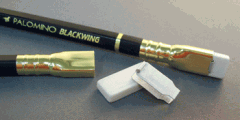From Obsolete Commodity to Status Symbol

Old fashioned wood and graphite pencils were once how we all wrote, but hit their popularity peak decades ago. They are high maintenance – as soon as you start using a sharpened pencil, its point begins to dull and the thickness of the line starts to change. Too sharp a point, and it will break or poke through the writing surface. Too dull, and it’s sloppy-looking. Above all, to maintain a good point you need to have a sharpener at hand. Sharpening itself can be messy, with shavings and graphite dust sometimes escaping the sharpener, which itself needs to be periodically emptied. Technology has delivered far more elegant solutions for those applications where pencil is preferred to pen, notably the great variety of mechanical pencils that maintain a constant point thickness and hold a reservoir of refills.
Can you think of a less likely candidate for a status symbol than a wood pencil?
Old Technology as Luxury
 A product with less than current technology can sometimes be turned into a status symbol or luxury item. The finest watches don’t use reliable and highly accurate quartz innards; rather, they rely on complex mechanical systems for winding and time-keeping. Their very complexity is a key part of their attraction! (See When Complicated Is Good.) Similarly, liquid-ink fountain pens have been completely replaced for everyday use by newer types, but are still offered by luxury brands like Montblanc. These and other products don’t focus on convenience and reliability; rather, they emphasize tradition, manufacturing quality, appearance, and the timeless nature of their products.
A product with less than current technology can sometimes be turned into a status symbol or luxury item. The finest watches don’t use reliable and highly accurate quartz innards; rather, they rely on complex mechanical systems for winding and time-keeping. Their very complexity is a key part of their attraction! (See When Complicated Is Good.) Similarly, liquid-ink fountain pens have been completely replaced for everyday use by newer types, but are still offered by luxury brands like Montblanc. These and other products don’t focus on convenience and reliability; rather, they emphasize tradition, manufacturing quality, appearance, and the timeless nature of their products.
Disposable Status?
The challenge to creating a luxury wood pencil brand is that the product itself is, to all appearances, cheap and disposable. Unlike a watch or fountain pen, a wood pencil is consumed as it is used, and eventually tossed. It doesn’t convey “status” to those around you, either, as it looks like what it is: a wood pencil, more or less indistinguishable from its peers.
The Blackwing Pencil
 I’m fairly dubious about Klout.com and their influence rating system, but I’ve peeked in now and then and have, very rarely, received a “perk.” The last one was an interesting package from California Cedar Products Company, now maker of the Blackwing pencil. While the product itself was a pair of pencils and a small sharpener, the packaging was an over-the-top attempt to signal exclusivity. A velvet bag, a simulated wax seal, a “limited edition” tag suggesting that I was #93 of 602 lucky recipients, and, best of all, a letter from the CEO.
I’m fairly dubious about Klout.com and their influence rating system, but I’ve peeked in now and then and have, very rarely, received a “perk.” The last one was an interesting package from California Cedar Products Company, now maker of the Blackwing pencil. While the product itself was a pair of pencils and a small sharpener, the packaging was an over-the-top attempt to signal exclusivity. A velvet bag, a simulated wax seal, a “limited edition” tag suggesting that I was #93 of 602 lucky recipients, and, best of all, a letter from the CEO.
The letter was written by hand, although reproduced in quantity. (Oddly, the lettering looked more pen-like to my untrained eye, but it was a pleasing reminder of when people actually wrote letters by hand. The nostalgia of a page-long handwritten letter ties in well with the product.) In the letter, Charles “Woodchuck” Berolzheimer invokes the names of past Blackwing users, including Frank Lloyd Wright, Steven Sondheim, and John Steinbeck. He refers to these luminaries as “legendary Blackwing artists,” and tells the recipient, “to create your own legacy of greatness.”
Apparently, there is some truth to the exclusivity of the product, in part because Blackwing pencils were discontinued by their original maker in 1998. Back in 2010, BoingBoing reported that an unused Blackwing “can sell for $40 on eBay.”
One of the sample pencils includes, foil-stamped on the pencil itself, a performance claim made for the original Blackwing, “Half the pressure, twice the speed.”
Appearance Differentiation
 It’s difficult to make a wood pencil look different than other wood pencils, but these had a replaceable rectangular eraser instead of the usual permanent round button most pencils sport. The eraser can even be pulled out a bit as it is used, giving the user a sort of “eraser reservoir.” That differentiates the appearance slightly, and also addresses the problem of the eraser being consumed while there’s still half a pencil remaining. Mistake-prone writers will find this a great asset, but I think the key advantage is that it’s the one Blackwing feature that can be spotted without careful inspection of the pencil.
It’s difficult to make a wood pencil look different than other wood pencils, but these had a replaceable rectangular eraser instead of the usual permanent round button most pencils sport. The eraser can even be pulled out a bit as it is used, giving the user a sort of “eraser reservoir.” That differentiates the appearance slightly, and also addresses the problem of the eraser being consumed while there’s still half a pencil remaining. Mistake-prone writers will find this a great asset, but I think the key advantage is that it’s the one Blackwing feature that can be spotted without careful inspection of the pencil.
Creativity Boost?
Purveyors of all kinds of products love to invoke the names of famous owners of the past, implying that some of their status is conveyed to current owners of the product. While I’m sure the letter was crafted entirely by marketers, the idea that an association with a creative genius could boost your own creativity isn’t totally absurd. If an image of a lightbulb can make you more creative (see 25-Cent Creativity Booster), why couldn’t writing with John Steinbeck’s pencil do the same thing for a struggling author? (Since the effect is in the mind of the user, it goes without saying that for the pencil to have that effect the user would have to know it was the same kind used by Steinbeck and Frank Lloyd Wright.)
Will Blackwing 2.0 Succeed?
I’m sure the world of pencil aficionados will delight in the renewed availability of the “legendary” Blackwing (but will no doubt complain bitterly about any minor changes in the new version). If California Cedar wants to succeed in a larger market, though, they face a real challenge: most people don’t think of a wood pencil with a rectangular eraser as a legend in its own time, or as a status symbol, or as a creativity tool. They haven’t heard of the brand, and don’t know of its history and association with famous personalities. And, even if the company succeeds in creating greater brand recognition, will average consumers decide to go back to pencils that need sharpening?
The price of the product is both good news and bad news. The good news is that the barrier to purchasing is low: a dozen costs about $20. That’s about ten times what a dozen Dixon Ticonderoga wood pencils cost, but it’s hardly a big hurdle if someone perceives that the product has a high cool factor. And, it’s a tiny fraction of the cost of an entry-level Montblanc fountain pen. The bad news is that even though the margins may be great when you sell a dozen pencils for $20 at retail, you need to convince a lot of customers to spend that $20 if you plan to build a sizable business. A dozen would last me for years, though I’m sure artists and writers (the few who don’t work electronically) would consume them more quickly. (Steinbeck, according to the CEO’s letter, could use 60 in a day. They were likely a lot cheaper then.)
What do you think? Can a social media push turn these pencils into a hot seller?
